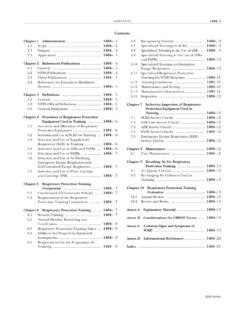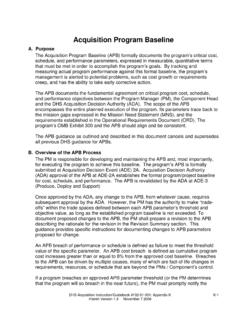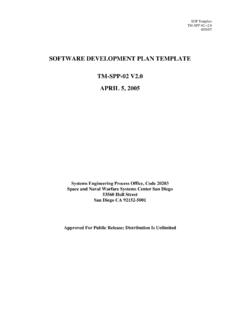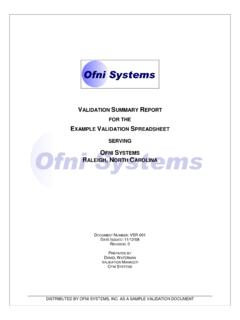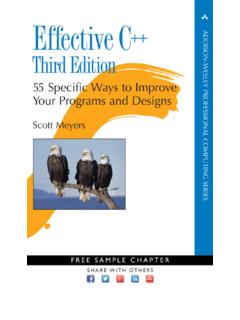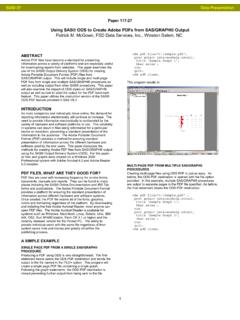Transcription of Sample pages of the TEMPLATE FOR A SOFTWARE …
1 Sample pages of the TEMPLATE FOR A SOFTWARE MAINTENANCE PLAN Introduction Background The hype surrounding the Year 2000 (Y2K) SOFTWARE crisis identified the need for solid SOFTWARE maintenance policies and practices. Many organizations were forced to deal with significant changes to their SOFTWARE inventory and expended considerable funds accomplishing the needed tasks. SOFTWARE systems are developed and evolve; they are not static. The last phase of the SOFTWARE engineering lifecycle, operation and maintenance, often takes the majority of life cycle funds. It is therefore prudent to possess SOFTWARE maintenance plans and procedures to contain life cycle costs, and to operate an efficient organization. SOFTWARE Engineering Process Technology (SEPT) in conjunction with the noted SOFTWARE Maintenance expert Thomas Pigoski has developed this TEMPLATE for a SOFTWARE Maintenance Plan to aid the SOFTWARE engineer in implementing SOFTWARE maintenance requirements.
2 This TEMPLATE is easy to use, self-explanatory, and does not require expensive training or extensive experience. About SOFTWARE Maintenance SOFTWARE maintenance is the totality of activities required to provide cost-effective support to a SOFTWARE system. Activities are performed during the pre-delivery stage as well as the post-delivery stage. Pre-delivery activities include planning for post-delivery operations, supportability, and logistics determination. Post-delivery activities include SOFTWARE modification, training, and operating a help desk. How to use this Document This document is designed to aid a person with limited knowledge of SOFTWARE maintenance requirements and methods to plan for SOFTWARE maintenance of a project or system. This TEMPLATE may be applied to manual or automated (computer processes) methods and can be easily implemented by one or more persons. It is applicable to small, highly critical 10-line SOFTWARE programs and to programs over 1 million lines of code.
3 Organizational Requirements Maintenance is performed by the developer, a separate maintainer, or by a third-party organization. It is important that the organization responsible for maintenance be identified in writing with full responsibilities. The Maintenance Plan accomplishes this. The maintainer should develop the Maintenance Plan as well as the supporting procedures. Since SOFTWARE maintenance activities invoke the use of organizational resources, it is recommended that the highest level of management in the organization approves of this undertaking and approves the final version of the plan and the procedures. Other functions that should also review and approve this plan include SOFTWARE Quality Assurance, SOFTWARE Engineering, SOFTWARE Testing, Project Management (when applicable), the organization s SOFTWARE Configuration Management Function (when applicable), and the customer (when applicable). This TEMPLATE s illustrative text is designed for use as is, by stripping the tutorial notations underlined in the text.
4 The text can also be modified for requirements and guidance to meet organizational needs, and unique environments. It is not a requirement to use the paragraph numbers contained in this document and additional comments are encouraged whenever appropriate to fully comply with an organizations specific requirements. This TEMPLATE is applicable to all types of SOFTWARE from information technology, commercial, scientific, and other non-business applications (such as creating a complex web site). The user of this TEMPLATE should spell out all of the issues that are prevailing regarding the need for SOFTWARE maintenance prior to tailoring the TEMPLATE to ascertain that all such organizational issues are addressed. Reference SOFTWARE Configuration Management Standards International Standards ISO/IEC 12207 1995. SOFTWARE Engineering - SOFTWARE Life Cycle Processes. ISO/IEC 14764 1999. SOFTWARE Engineering - SOFTWARE Maintenance USA Standards (International application) IEEE/EIA 1996, , , IEEE 1219 - 1998.
5 SOFTWARE Maintenance Defense Standards (USA) J-STD-16-1998 (30 Sept 95), Standard for Information Technology, SOFTWARE Life Cycle Processes. Standards and Specifications may be procured through SEPT at Reference Books Practical SOFTWARE Maintenance: Best Practices for Managing Your SOFTWARE Investment, Thomas M. Pigoski, John Wiley and Sons, New York, 1997. To order this book click on to Guide to SOFTWARE Engineering Standards and Specifications, S. Magee and L Tripp. Artech House, 1997. To order this book click on to Warranties and Liability SEPT makes no warranties, implied or stated with respect to this TEMPLATE and it is provided on an as is basis . SEPT will have no liability for any indirect, incidental, special or consequential damages or any loss of revenue or profits arising under, or with respect to the use of this document. General Requirements This section should describe the policies and responsibilities of the program/project team as it plans for SOFTWARE maintenance.
6 Policies and responsibilities are usually spelled out in an organization policy/directives manual and may be referenced here. It is highly recommended, however, that such doctrine be summarized in the plan as illustrated below. Introduction This section describes the system to be supported and identifies the initial status of the system. Complete identification of the system should include formal and common names, nomenclature, identification number and system abbreviations. Subsystems and interfacing systems should be identified. This plan describes the processes and procedures necessary to provide SOFTWARE maintenance for the XYZ system. System XYZ, Version is being developed by the SOFTWARE Development of Company ABC and the SOFTWARE Maintenance Department of Company ABC will perform all SOFTWARE maintenance functions. NOTE: If the developer will perform maintenance, the following would be used. The SOFTWARE Development Department of Company ABC is developing SYSTEM XYZ Version SOFTWARE maintenance will also be performed by the SOFTWARE Development Department.
7 NOTE: If maintenance were outsourced to another company, the following would be used. System XYZ, Version is being developed by Company ABC and will transition to Company DEF for SOFTWARE maintenance support. System XYZ contains subsystems COLLECTION, PROCESSING, and REPORTING. System XYZ interfaces with systems QRS and STU. This plan details the activities required and specifies the various responsibilities in order to provide SOFTWARE maintenance for System XYZ. System. Describe the mission of the system to include mission need and employment. Identify interoperability requirements. Describe system functions. Describe the system to include descriptions of: system architecture, components and interfaces; hardware and SOFTWARE . Use separate subparagraphs to describe each subsystem and major hardware/ SOFTWARE component. System XYZ provides payroll processing for a small business. It provides input to a third party payroll company called ADP Inc. The data provided must be in a format compatible with ADP Inc.
8 Requirements. System XYZ takes input from timecards, aggregates them, and formats the data to be forwarded to ADP Inc. Status. Identify the initial status of the system. System XYZ is under development and replaces System XY. System XY is a semi-automated system that is not integrated into corporate operations. System XYZ will provide that integration and additional functionality. Support. Describe why support is needed. System XYZ has a projected life of 3 years. During that period, corrections and enhancements will be required. Corrective maintenance will accommodate latent defects as reported by users. Enhancements, or improvements will be submitted in order to improve performance and provide additional functionality for the users. As a result, maintenance support is required. Maintainer. Identify the maintainer. The maintainer for System XYZ is the SOFTWARE Maintenance Department of the ABC Company. (NOTE: or the SOFTWARE Maintenance Department of the DEF company if maintenance is provided by an outside source.)
9 Or the SOFTWARE Development Department if there is no transition to a separate maintenance organization.) Contracts. Describe any contractual protocols between customer and supplier. The SOFTWARE Development Department of Company ABC has a signed Memorandum of Agreement with the SOFTWARE Maintenance Department of Company ABC to provide SOFTWARE maintenance for system XYZ. Through a Configuration Control Board (CCB), agreement will be reached on what corrections and enhancements will be provided in the next release. Emergency support is on an hourly basis. NOTE: For outside support use the following: Company ABC has a signed Memorandum of Agreement with Company DEF to provide SOFTWARE maintenance for system XYZ. Through a Configuration Control Board, agreement will be reached on which corrections and enhancements will be provided in the next release. Emergency support is on an hourly basis. Maintenance Concept Describe the concept. The maintenance concept addresses: The scope of SOFTWARE maintenance; the tailoring of the post-delivery process; the designation of who will provide maintenance; and an estimate of life-cycle costs.
10 The customer should develop it early in the development effort with help from the maintainer. Defining the scope of maintenance helps the customer determine exactly how much support the maintainer will give to the customer. Scope relates to how responsive the maintainer will be to the users. The maintenance concept also addresses the activities of post-delivery SOFTWARE maintenance. Different organizations often perform different activities in the post-delivery process. An early attempt should be made to identify these organizations and to document them in the maintenance concept. In many cases, a separate maintenance organization performs the maintenance functions. Figuring out who or which maintenance organization should perform maintenance for a particular system involves many factors. If the system only has a lifespan of two years, perhaps the developer should maintain it. Concept. Responsiveness to the user community is the primary consideration in determining the scope of SOFTWARE maintenance.

